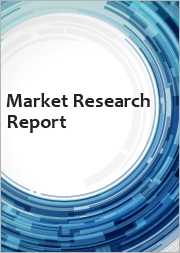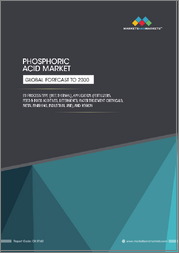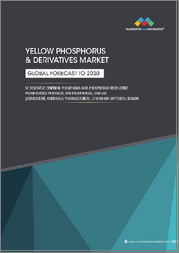
|
시장보고서
상품코드
1645295
세계의 인산 시장 평가 : 형태별, 등급별, 용도별, 최종사용자별, 지역별, 기회 및 예측(2018-2032년)Phosphoric Acid Market Assessment, By Form, By Grade, By Application, By End-user, By Region, Opportunities and Forecast, 2018-2032F |
||||||
세계 인산 시장은 2024년부터 2032년까지 예측 기간 동안 4.06%의 연평균 복합 성장률(CAGR)을 나타내고, 2024년 472억 9,000만 달러에서 2032년 650억 달러로 성장할 것으로 예상됩니다.
세계 인산 시장은 다양한 분야, 특히 농업 분야 수요 증가에 힘입어 역동적인 변화를 겪고 있습니다. 인산염은 인산염을 주성분으로 하는 비료의 주요 성분으로, 인구가 증가하는 세계에서 작물 수확량을 높이고 식량 안보를 보장하는 데 중요한 역할을 하고 있습니다. 각국이 농업 생산성을 높이기 위해 노력하는 가운데 인산의 중요성은 계속 증가하고 있으며, 세계 시장에서 필수적인 상품으로 자리매김하고 있습니다.
예를 들어, 2023년 8월, 9개의 이집트 기업 컨소시엄은 Abu Tartur에서 12억 달러 규모의 인산 생산 프로젝트를 개발할 계획을 세웠습니다. 이 회사는 연간 최대 90만 톤의 54% 농도의 인산 생산량을 목표로 하고 있으며, 가능한 금융 기관으로부터의 자금 조달 및 잠재적 투자자와의 파트너십을 고려하고 있습니다. 이 프로젝트는 인산 생산에 대한 투자 급증과 역량 기반 개발을 위해 노력하는 국내 기업의 시너지 효과를 보여주고 있습니다.
이 협약은 창의적인 제휴와 전략적 투자를 통해 농업 및 기타 농약 분야에서 인산 사용이 확대되고 있는 광범위한 인산 시장 동향과 일치합니다. 아부 타르툴 프로젝트는 세계 공급망에 영향을 미치면서 지속 가능한 농업 관행을 지원할 수 있는 지역적 행동을 반영하는 대표적인 사례입니다.
목차
제1장 프로젝트의 범위와 정의
제2장 조사 방법
제3장 주요 요약
제4장 고객의 소리
- 응답자 인구통계
- 구입 결정시에 고려되는 요소
- 가격
- 공급망과 리드타임
- 인산 등급
- 제품 품질
- 응모 요건
제5장 세계의 인산 시장 전망, 2018년-2032년
- 시장 규모 분석과 예측
- 금액별
- 수량별
- 시장 점유율 분석과 예측
- 형태별
- 액체
- 고체
- 등급별
- 식품 등급
- 테크니컬 등급
- 비료 등급
- 전자 등급
- 용도별
- 비료
- 식품 및 사료첨가물
- 세제
- 수처리 약품
- 금속 치료
- 기타
- 최종사용자별
- 농업
- 식품 및 음료
- 화학제품
- 수처리
- 야금
- 기타
- 지역별
- 북미
- 유럽
- 아시아태평양
- 남미
- 중동 및 아프리카
- 기업별 시장 점유율 분석(주요 5개사 및 기타 - 금액별, 2024년)
- 형태별
- 시장 맵 분석, 2024년
- 형태별
- 등급별
- 용도별
- 최종사용자별
- 지역별
제6장 북미의 인산 시장 전망, 2018년-2032년
- 시장 규모 분석과 예측
- 금액별
- 수량별
- 시장 점유율 분석과 예측
- 형태별
- 액체
- 고체
- 등급별
- 식품 등급
- 테크니컬 등급
- 비료 등급
- 전자 등급
- 용도별
- 비료
- 식품 및 사료첨가물
- 세제
- 수처리 약품
- 금속 치료
- 기타
- 최종사용자별
- 농업
- 식품 및 음료
- 화학제품
- 수처리
- 야금
- 기타
- 국가별 점유율
- 미국
- 캐나다
- 멕시코
- 형태별
- 국가별 시장 평가
- 미국의 인산 시장 전망, 2018년-2032년
- 시장 규모 분석과 예측
- 시장 점유율 분석과 예측
- 캐나다
- 멕시코
- 미국의 인산 시장 전망, 2018년-2032년
모든 부문은 대상이 되는 모든 지역과 국가에서 제공됩니다.
제7장 유럽의 인산 시장 전망, 2018년-2032년
- 독일
- 프랑스
- 이탈리아
- 영국
- 러시아
- 네덜란드
- 스페인
- 터키
- 폴란드
제8장 아시아태평양의 인산 시장 전망, 2018년-2032년
- 인도
- 중국
- 일본
- 호주
- 베트남
- 한국
- 인도네시아
- 필리핀
제9장 남미의 인산 시장 전망, 2018년-2032년
- 브라질
- 아르헨티나
제10장 중동 및 아프리카의 인산 시장 전망, 2018년-2032년
- 사우디아라비아
- 아랍에미리트(UAE)
- 남아프리카공화국
제11장 Porter의 Five Forces 분석
제12장 PESTLE 분석
제13장 시장 역학
- 시장 성장 촉진요인
- 시장이 해결해야 할 과제
제14장 시장 동향과 발전
제15장 사례 연구
제16장 경쟁 구도
- 시장 리더 주요 5개사의 경쟁 매트릭
- 주요 5개 기업의 SWOT 분석
- 주요 기업 주요 10개사의 시장 구도
- The Mosaic Company
- 기업 개요
- 주요 경영진
- 제품과 서비스
- 재무 상황(보고된 대로)
- 주요 시장 포커스와 지역 존재감
- 최근 동향/협업/파트너십/합병과 인수
- Nutrien Ltd.
- ICL Group Ltd
- OCP SA
- The Saudi Arabian Mining Company(Ma'aden)
- Wengfu &Zijin Chemical Industry Co., Ltd.
- Jordan Phosphate Mines Co. Plc
- JR Simplot Company
- Solvay SA
- Indian Farmers Fertiliser Cooperative Limited(IFFCO)
- The Mosaic Company
위에 언급된 회사는 시장 점유율에 따른 순위를 보유하지 않으며, 조사 작업 중 이용 가능한 정보에 따라 변경될 수 있습니다.
제17장 전략적 제안
제18장 리서치사에 대해 & 면책사항
LSH 25.02.24Global phosphoric acid market is projected to witness a CAGR of 4.06% during the forecast period 2024-2032, growing from USD 47.29 billion in 2024 to USD 65 billion in 2032.
The global phosphoric acid market is undergoing dynamic changes, driven by increasing demand across various sectors, particularly agriculture. It is a key ingredient in phosphate-based fertilizer, playing a crucial role in boosting crop yields and ensuring food security in a world with a growing population. As countries strive to enhance agricultural productivity, the significance of phosphoric acid continues to rise, solidifying its status as an essential commodity in the global market.
For instance, in August 2023, a nine Egyptian firms consortium planned to develop a USD 1.2 billion phosphoric acid production project in Abu Tartur. The firm is targeting up to 900,000 tons annually of 54% concentration of phosphoric acid and looking at funding sources from available financing institutions and prospective partnerships with potential investors. This project indicates the surging investments in phosphoric acid production and the synergies of domestic players working to develop their capability base.
This agreement aligns with wider market trends for phosphoric acid, where creative collaborations and strategic investment are expanding the usage of phosphoric acid in agriculture and other agrochemical applications. The Abu Tartur project is a prime illustration reflecting regional action that may support sustainable agriculture practices while impacting global supply chains.
Rising Demand for Food-Grade Phosphoric Acid
The phosphoric acid market is booming with increasing demand in several sectors, mainly food and beverages. A significant growth driver for phosphoric acid has been the use of food-grade phosphoric acid. Food-grade phosphoric acid is indispensable in its application in flavoring, regulation of acidity, and preservation in processed foods and beverages. With the increase in global food consumption, there is a growing need for high-quality food-grade phosphoric acid to meet regulatory standards and consumer expectations for safe and effective food additives.
Major demand for food-grade phosphoric acid comes from Europe and other international markets, wherein the consumer penchant for improved food quality and higher safety standards dictates the industry.
For instance, in November 2024, the Elixir Group expanded food-grade phosphoric acid production at its Prahovo Industrial and Chemical Park, to its current output capacity. Further, the firm plans to commission an additional phosphoric acid plant and build a water pipeline. The rise in market production by companies such as Elixir Group, which assures quality standards, particularly by European market manufacturers, to meet the increasing demand for food-grade phosphoric acid, is likely to fuel market growth. The company provided food-grade phosphoric acid to soft drinks manufacturers or yeast producers.
Technological Innovations in Phosphoric Acid Recycling are Expected to Drive the Market
The phosphoric acid market is highly driven by technological advancements in recycling. Technological change will likely influence the market to introduce new methods of phosphorus recovery and reuse. This may expand further applications in areas such as electronics, pharmaceuticals, and many other manufacturing processes, such as fertilizer, the food and beverage market, etc.
Further, companies are focusing on recycling phosphoric acid. For example, Mitsui Chemicals, Inc. focuses on recovering phosphoric acid from underused phosphorus resources and converting it into high-value-added products for reuse in the manufacturing industry. Mitsui aims to expand phosphorus applications, especially beyond its traditional use in fertilizers for the agricultural sector.
Mitsui Chemicals, through one of its subordinates, Shimonoseki Mitsui Chemicals, set out to address this, considering its capabilities regarding catalytic chemistry. Shimonoseki Mitsui Chemicals is a particular company because of its production process of phosphoric acid via wet process, the sole company in Japan. With most research institutions and partner industries well-versed in phosphoric acid technology and other pertinent technologies, this company aimed to improve the technological development of phosphoric acid. These innovations, such as recycling technology from Mitsui Chemicals, will drive the phosphoric acid market, as they are the next step toward more sustainable and efficient resource utilization.
Dominance of Fertilizers Application in Phosphoric Acid Market
Fertilizers are a major application in the phosphoric acid market since phosphoric acid is a key ingredient in many fertilizers used in modern agriculture. Mono-ammonium phosphate (MAP), di-ammonium phosphate (DAP), and Triple superphosphate (TSP) are some of the fertilizers that rely on phosphoric acid for their production. These fertilizers are crucial in increasing soil fertility and maximizing crop yields, which becomes increasingly important as food demands continue to rise around the world.
An upward trend in phosphoric acid production is witnessed along with the focus placed on sustainable agriculture and food security. Farmers and agricultural producers will always look forward to increasing their productivity, and therefore, phosphoric acid is a chemical that plays an important role here. Thus, investments in plants for the manufacture of phosphoric acid are getting more frequent.
In May 2023, the Jordan Phosphate Mines Company (JPMC) and Transpet, a Turkish firm, signed an agreement to establish a new phosphoric acid plant in the Sheidiya area of Maan Governorate. This plant will have an annual production capacity of 165,000 tons, highlighting the strategic investments in the phosphoric acid sector to bolster fertilizer production and enhance agricultural efficiency. This collaboration signifies a commitment to increasing domestic production and aims to strengthen Jordan's position in the global phosphoric acid market.
Asia-Pacific to Witness Highest Growth Rate in Phosphoric Acid Market
Asia-Pacific has been facing an increasing demand from the agriculture and food industries, rapid industrialization, and major investments in chemical manufacturing. This is mainly spearheaded by the two countries that lead the Asia-Pacific market, India and China, with the latter also being spurred on by an ever-growing population and food security concerns. The rise in fertilizer production to improve crop yields and the growing usage of phosphoric acid in food additives and water treatment applications are major drivers for the market. Additionally, government policies that encourage the use of sustainable agricultural practices and infrastructure development are supporting the growth of the phosphoric acid market in this region.
India has a strong agricultural sector, and increasing investment in chemical manufacturing facilities is expected to make it a major player. The country's conducive regulatory environment, along with its focus on self-sufficiency in fertilizer production, attracts more industries. Leading players take these opportunities and erect new production facilities, benefiting from modern technologies.
For instance, in April 2024, Coromandel International Limited, one of India's leading Agri solutions providers, announced to set up a phosphoric acid and sulphuric acid production complex in Kakinada, Andhra Pradesh. The new facility will produce 650 tons per day (tpd) of phosphoric acid, will utilize state-of-the-art DA-HF (Dihydrate Attack-Hemihydrate Filtration) process technology and an automated DCS system, cementing the region's status as a growth engine for the phosphoric acid market. The project is expected to be completed in coming two years with an investment of around USD 116 million.
Future Market Scenario (2025 - 2032F)
The rising world population and food security concerns will require higher consumption of fertilizers, with phosphorus-based ones likely to grow at an accelerating pace. With growing interest in increasing agricultural productivity across the world, the consumption of phosphoric acid in DAP and MAP will also rise steadily.
Advanced filtration techniques and energy-efficient methods in production processes are expected to improve the yield and quality of phosphoric acid. Such improvements will also reduce environmental impact, as stricter global sustainability regulations are set, and more widespread use is encouraged across industries.
While fertilizers still dominate the market for phosphoric acid, application in food additives, water treatment, and industrial applications for detergents and metal treatment is going to grow. These diversifications of the sector can make it even more immune from sectoral disturbances.
Asia-Pacific will be a significant growth region, given the rapid industrialization, increased agricultural needs, and investments in chemical manufacturing. Countries like India and China will lead in consumption and production capacities, supported by government initiatives and private investments.
Key Players Landscape and Outlook
The phosphoric acid market is dynamic in nature, with several key players pushing the boundaries for innovation and production. Phosphoric acid finds its application primarily as a crucial ingredient in fertilizers, besides its use in food processing and chemical manufacturing industries.
For instance, in December 2024, Prayon SA signed a technology license agreement with First Phosphate Corp. to produce merchant-grade phosphoric acid. This license allows First Phosphate to use Prayon SA technology to design, build, operate, and maintain a merchant Grade phosphoric acid (MGA) plant in Canada producing 600 metric tons of P2O5 per day. This not only indicates the significance of the development of technology in the phosphoric acid industry but also indicates that igneous phosphate rock can be used for sustainable purposes.
Such collaborations are essential as they expand production capacities and encourage responsible practices for the environment. The collaboration between First Phosphate and Prayon SA serves as an example of how strategic partnerships can facilitate progress in the phosphoric acid market, helping companies maintain competitiveness and cater to the ever-growing global demand for fertilizers and other uses.
Table of Contents
1. Project Scope and Definitions
2. Research Methodology
3. Executive Summary
4. Voice of Customer
- 4.1. Respondent Demographics
- 4.2. Factors Considered in Purchase Decisions
- 4.2.1. Price
- 4.2.2. Supply Chain and Lead Time
- 4.2.3. Phosphoric Acid Grade
- 4.2.4. Product Quality
- 4.2.5. Application Requirement
5. Global Phosphoric Acid Market Outlook, 2018-2032F
- 5.1. Market Size Analysis & Forecast
- 5.1.1. By Value
- 5.1.2. By Volume
- 5.2. Market Share Analysis & Forecast
- 5.2.1. By Form
- 5.2.1.1. Liquid
- 5.2.1.2. Solid
- 5.2.2. By Grade
- 5.2.2.1. Food Grade
- 5.2.2.2. Technical Grade
- 5.2.2.3. Fertilizer Grade
- 5.2.2.4. Electronic Grade
- 5.2.3. By Application
- 5.2.3.1. Fertilizers
- 5.2.3.2. Food and Feed Additives
- 5.2.3.3. Detergents
- 5.2.3.4. Water Treatment Chemicals
- 5.2.3.5. Metal Treatment
- 5.2.3.6. Others
- 5.2.4. By End-user
- 5.2.4.1. Agriculture
- 5.2.4.2. Food and Beverage
- 5.2.4.3. Chemical
- 5.2.4.4. Water Treatment
- 5.2.4.5. Metallurgy
- 5.2.4.6. Others
- 5.2.5. By Region
- 5.2.5.1. North America
- 5.2.5.2. Europe
- 5.2.5.3. Asia-Pacific
- 5.2.5.4. South America
- 5.2.5.5. Middle East and Africa
- 5.2.6. By Company Market Share Analysis (Top 5 Companies and Others - By Value, 2024)
- 5.2.1. By Form
- 5.3. Market Map Analysis, 2024
- 5.3.1. By Form
- 5.3.2. By Grade
- 5.3.3. By Application
- 5.3.4. By End-user
- 5.3.5. By Region
6. North America Phosphoric Acid Market Outlook, 2018-2032F*
- 6.1. Market Size Analysis & Forecast
- 6.1.1. By Value
- 6.1.2. By Volume
- 6.2. Market Share Analysis & Forecast
- 6.2.1. By Form
- 6.2.1.1. Liquid
- 6.2.1.2. Solid
- 6.2.2. By Grade
- 6.2.2.1. Food Grade
- 6.2.2.2. Technical Grade
- 6.2.2.3. Fertilizer Grade
- 6.2.2.4. Electronic Grade
- 6.2.3. By Application
- 6.2.3.1. Fertilizers
- 6.2.3.2. Food and Feed Additives
- 6.2.3.3. Detergents
- 6.2.3.4. Water Treatment Chemicals
- 6.2.3.5. Metal Treatment
- 6.2.3.6. Others
- 6.2.4. By End-user
- 6.2.4.1. Agriculture
- 6.2.4.2. Food and Beverage
- 6.2.4.3. Chemical
- 6.2.4.4. Water Treatment
- 6.2.4.5. Metallurgy
- 6.2.4.6. Others
- 6.2.5. By Country Share
- 6.2.5.1. United States
- 6.2.5.2. Canada
- 6.2.5.3. Mexico
- 6.2.1. By Form
- 6.3. Country Market Assessment
- 6.3.1. United States Phosphoric Acid Market Outlook, 2018-2032F*
- 6.3.1.1. Market Size Analysis & Forecast
- 6.3.1.1.1. By Value
- 6.3.1.1.2. By Volume
- 6.3.1.2. Market Share Analysis & Forecast
- 6.3.1.2.1. By Form
- 6.3.1.2.1.1. Liquid
- 6.3.1.2.1.2. Solid
- 6.3.1.2.2. By Grade
- 6.3.1.2.2.1. Food Grade
- 6.3.1.2.2.2. Technical Grade
- 6.3.1.2.2.3. Fertilizer Grade
- 6.3.1.2.2.4. Electronic Grade
- 6.3.1.2.3. By Application
- 6.3.1.2.3.1. Fertilizers
- 6.3.1.2.3.2. Food and Feed Additives
- 6.3.1.2.3.3. Detergents
- 6.3.1.2.3.4. Water Treatment Chemicals
- 6.3.1.2.3.5. Metal Treatment
- 6.3.1.2.3.6. Others
- 6.3.1.2.4. By End-user
- 6.3.1.2.4.1. Agriculture
- 6.3.1.2.4.2. Food and Beverage
- 6.3.1.2.4.3. Chemical
- 6.3.1.2.4.4. Water Treatment
- 6.3.1.2.4.5. Metallurgy
- 6.3.1.2.4.6. Others
- 6.3.1.2.1. By Form
- 6.3.1.1. Market Size Analysis & Forecast
- 6.3.2. Canada
- 6.3.3. Mexico
- 6.3.1. United States Phosphoric Acid Market Outlook, 2018-2032F*
All segments will be provided for all regions and countries covered
7. Europe Phosphoric Acid Market Outlook, 2018-2032F
- 7.1. Germany
- 7.2. France
- 7.3. Italy
- 7.4. United Kingdom
- 7.5. Russia
- 7.6. Netherlands
- 7.7. Spain
- 7.8. Turkey
- 7.9. Poland
8. Asia-Pacific Phosphoric Acid Market Outlook, 2018-2032F
- 8.1. India
- 8.2. China
- 8.3. Japan
- 8.4. Australia
- 8.5. Vietnam
- 8.6. South Korea
- 8.7. Indonesia
- 8.8. Philippines
9. South America Phosphoric Acid Market Outlook, 2018-2032F
- 9.1. Brazil
- 9.2. Argentina
10. Middle East and Africa Phosphoric Acid Market Outlook, 2018-2032F
- 10.1. Saudi Arabia
- 10.2. UAE
- 10.3. South Africa
11. Porter's Five Forces Analysis
12. PESTLE Analysis
13. Market Dynamics
- 13.1. Market Drivers
- 13.2. Market Challenges
14. Market Trends and Developments
15. Case Studies
16. Competitive Landscape
- 16.1. Competition Matrix of Top 5 Market Leaders
- 16.2. SWOT Analysis for Top 5 Players
- 16.3. Key Players Landscape for Top 10 Market Players
- 16.3.1. The Mosaic Company
- 16.3.1.1. Company Details
- 16.3.1.2. Key Management Personnel
- 16.3.1.3. Products and Services
- 16.3.1.4. Financials (As Reported)
- 16.3.1.5. Key Market Focus and Geographical Presence
- 16.3.1.6. Recent Developments/Collaborations/Partnerships/Mergers and Acquisition
- 16.3.2. Nutrien Ltd.
- 16.3.3. ICL Group Ltd
- 16.3.4. OCP S.A.
- 16.3.5. The Saudi Arabian Mining Company (Ma'aden)
- 16.3.6. Wengfu & Zijin Chemical Industry Co., Ltd.
- 16.3.7. Jordan Phosphate Mines Co. Plc
- 16.3.8. J.R. Simplot Company
- 16.3.9. Solvay SA
- 16.3.10. Indian Farmers Fertiliser Cooperative Limited (IFFCO)
- 16.3.1. The Mosaic Company
Companies mentioned above DO NOT hold any order as per market share and can be changed as per information available during research work.



















